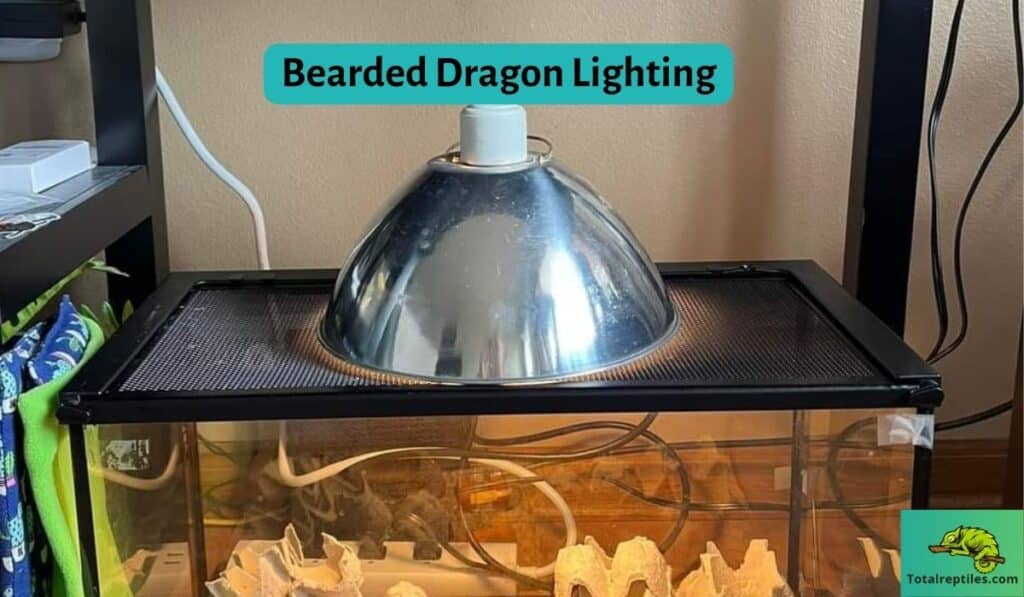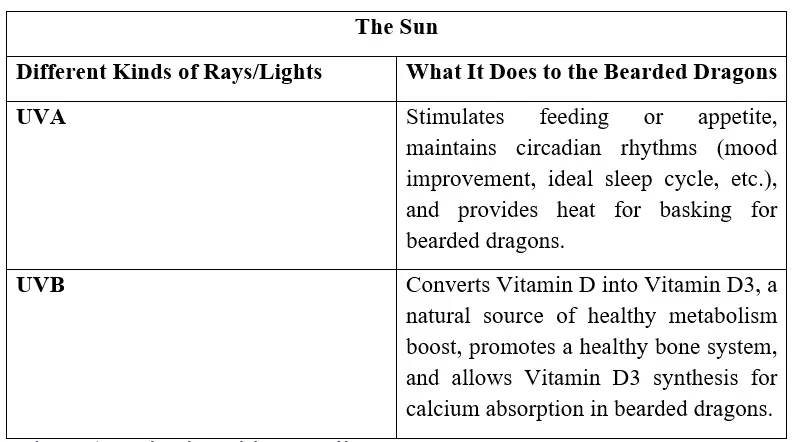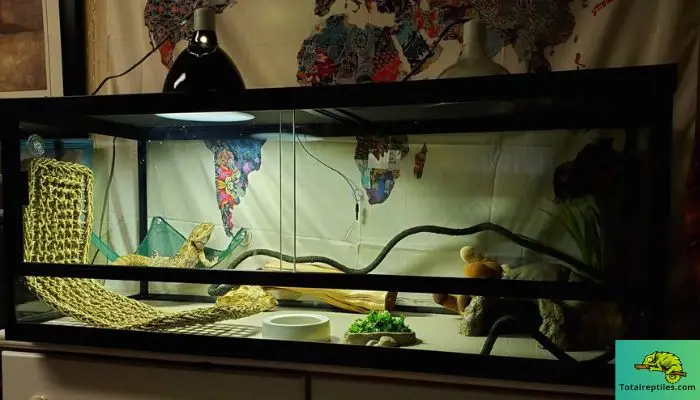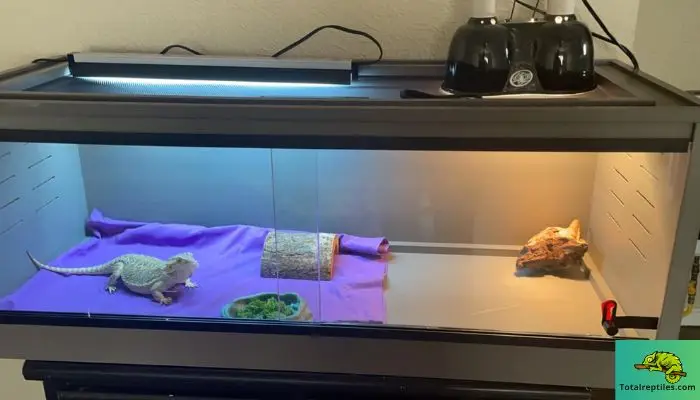Pogona vitticeps, commonly known as beardies, are one of the most loveable species in the reptile classification. However, setting the bearded dragon lighting is one of the challenging tasks for a beginner.
Know that this setup must resemble the sunlight in their natural habitat. It is the ultimate guide for a bearded dragon to live long and happily in captivity. So, you have to make sure the enclosure for your adorable pet offers the right lighting installation to simulate helpful sun rays (UV).
The only problem most new keepers face is not knowing what type of lighting to go for or why selective lighting is necessary. You need to acquaint yourself with these things to ensure a safe environment for the dragon.

Continue reading the article to discover what you need and why!
Importance of Lighting for Bearded Dragons
Remember that heat and light sources are enormously vital for the proper biological function of a bearded dragon. First, understand how it lives in the wild to apply such simulation in captivity.
Natural Habitat of Bearded Dragons
Beardies are natives of Central Australia, where the landscape is somewhat dry with varied vegetation, deserts, forests, and a bushy environment.
This particular region offers low humidity with an abundance intensity of ultraviolet rays from the sun. The rays contain UVA and UVB, both are equally essential for the reptile to survive.
It is because the UVB enables Vitamin D3 synthesis to prevent health diseases and plays a major role in calcium absorption. Similarly, UVA stimulates overall health alongside basking, feeding, and breeding.
Significance of Proper Lighting in Vivarium
A study of two groups of juvenile bearded dragons showed that exposure to UVB rays of one group had better growth due to the increased vitamin D3 supplement than the other.
So, the desert vivarium/enclosure must offer UVA/UVB light to prevent metabolic bone disease and other deficits.
It also helps regulate their circadian rhythms – the physical, mental, and behavioral shifts occurring in a 24-hour cycle.

What Lights Do Bearded Dragons Need?
You will need lights that offer 12-hour intense light and proper heat for the beardie to thrive. These have to mimic the desert daylight environment with adequate UVA/UVB radiation (approximately 5% – 7%).
Here are some lighting bulb types you can opt for:

- Halogen
It is new for hobbyists but quite efficient in energy consumption rates. Halogen bulbs come in mini and standard sizes (UVA and UVB) to fit the needs of many reptile habitats.
- Incandescent
These UVA and UVB bulbs are the most common and ideal for enthusiasts. It offers multiple sizes and shapes to provide excellent basking and heating areas.
- Linear Fluorescent
It is mainly a UVB bulb with a horizontally long tube structure, making it a common choice for many.
- Metal Halide
The Metal halide UVA and UVB bulbs require a ballast to function and deliver higher power.
- Mercury Vapor
Ensuring you provide a quality lamp fixture, these UVA and UVB bulbs produce reasonable heat amounts.
- Compact Fluorescent
The specialties of these UVA and UVB bulbs are the space-saving smaller form and coil design.
- Ceramic
It is a durable UVA and UVB bulb that produces intense heat despite low light emission. Thus, ceramic lamp fixture is recommended.
Choosing the Right Lighting for Your Bearded Dragon
Do you know when bearded dragons are happiest in captivity? It is when the vivarium offers a thermal gradient similar to its natural habitat.
In short, make sure to install a UVB bulb with the right wattage and fixture to imitate the sun rays of the Central Australia desert.
As a result, the enclosure may require an additional UVA lighting source (unless it is a metal halide bulb) in conjunction to compensate for the ideal temperature changes.
Adult Pogona vitticeps prefer basking under 95˚F-100˚F with a warmer side of 90˚F-95˚F. However, juveniles or baby beardies love the heat. Hence, maintain a 100˚F- 110˚F basking spot and a 95˚F-100˚F warmer area.
Setting Up Your Bearded Dragon’s Lighting
Find the enclosure dimension to figure out the light placement and size needed. It is the most critical feature to keep the dragon healthy.
Light Placement
Whatever the tank size is, make sure the light you select covers about 2/3 – ¾ or 80% length of the area. This enables the reptile to absorb sufficient UVB rays no matter the resting/sitting location.
Include a platform (sturdy branch or a large rock) about 10-12 inches below the basking light to keep the body warm. Add more substrate if the height is greater.
Use a screen cover or mesh instead of glass for better exposure on the top.
Cool Zone
The enclosure should also have a cool region/territory on the other side, which should be about 1/3 – 1/4 of a small portion.
This area is essential for the beardie to cool off when overheating. It helps it to dissipate the extra heat to regulate its body temperature.
Lastly, invest in a temperature gauge in the tank to keep track of the proper heat control. It may even be life-saving for the beardie!
Maintaining Your Bearded Dragon’s Lighting
The lights you install are not permanent. These will wear out eventually. But the trick is to replace them before the dullness is highly noticeable. Furthermore, how long should the light stay on?
Light Cycle
The lighting needs to replicate the rising and setting of the natural light source (sun). Keeping a 7 AM – 7 PM daylight timer can prevent disrupting the routine of your bearded dragon.
However, it can vary just as the sun affects our waking up schedule in various seasons.
So we recommend altering the hours according to seasonal changes. For instance:
| Seasons | Daytime Light |
| Summer | 14-16 Hours |
| Winter | 10-12 Hours |
Light Maintenance
Most lights are susceptible to wear out after six months or less. The longevity relies on the light type and its quality. Keep an eye on the duration when the light begins to flicker or dim down. Then, follow the pattern to replace it each time.
Usually, you may need to change the bulbs two to three times a year to avoid disturbance in the day and night cycles indoors.
Do Bearded Dragons Need Light at Night?
Thankfully bearded dragons sleep at night in the dark as most humans do. The basking and UVB lights are very bright and can disrupt the day and night pattern if kept on for 24 hours.

Then what is suitable for them at night?
Red Lights
Many arguments are circulating about red light use in an enclosure inhabited by a reptile. Although beardies do not have pit vision while being cold-blooded, red lights can be harmful if exposed for long hours.
Red light bulbs are visible and upsetting to the docile-natured creatures despite providing adequate heat at night. It may cause the dragons to miss sleep time, affecting the eyes.
Nighttime red lighting is often associated with appetite loss, stress, and a complex immune system in Pogona.
IR Lights
The infrared light, or IR, delivers a similar heat gradient in the enclosure but has no visibility or luminosity to affect the eyes. As a result, it can aid in keeping the pet warm at night.
This means proper temperature control (no less than 75˚F) even if the indoor area is cool.
Frequently Asked Questions
- Do baby bearded dragons need light at night?
Yes, they retain greater heat by basking than adult bearded dragons to absorb Vitamin D3 from the UVB lights. Thus, it is wise to install a night light (infrared) to prevent the low-temperature issue. It will keep them warm and healthy.
- How long should a bearded dragon’s light be on?
Follow the natural sunlight pattern to achieve proper lighting duration. A minimum of 12-hour light exposure for basking is crucial.
The hourly pattern may change seasonally:
- Summer: 14-16 hours (daytime light); 8-10 hours (nighttime)
- Winter: 10-12 hours (daytime light); 12-14 hours (nighttime).
- Do bearded dragons need light 24/7?
No, overexposure to bright UVB/UVA lighting can result in sleep disorders in bearded dragons. It will also cause a lack of appetite, eye damage, stress, and a difficult immune system. Maintain a solid 12-14 hours of daylight while total darkness at night hours for good sleep.
- Can I use a regular bulb for a basking light?
Yes, just make sure it offers the specific thermal gradient a bearded dragon requires for basking.
Conclusion
Being entitled to unique yet lovely reptiles, the keepers must ensure the bearded dragon lighting is proper and suitable for healthy physiological function.
Plus, the UVA and UVB lights are one of the key sources of their survival in captivity, so try not to overlook this matter.
Finally, ready the tank/enclosure before bringing home the new member. It will help the bearded dragon to adjust to the new setting without you constantly hovering around.
If you see it gaping while basking, know that you are treating the lizard right!

